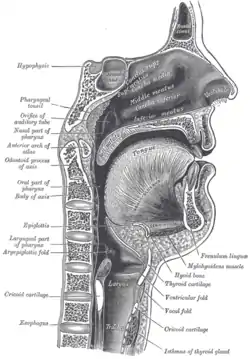Vocal tract
The vocal tract is the cavity in human bodies and in animals where the sound produced at the sound source (larynx in mammals; syrinx in birds) is filtered.
| Vocal tract | |
|---|---|
 Sagittal section of human vocal tract | |
| Anatomical terminology |
In birds it consists of the trachea, the syrinx, the oral cavity, the upper part of the esophagus, and the beak. In mammals it consists of the laryngeal cavity, the pharynx, the oral cavity, and the nasal cavity.
The estimated average length of the vocal tract in adult male humans is 16.9 cm and 14.1 cm in adult females.[1]
See also
- Language
- Talking birds – species of birds capable of imitating human sounds, but without known comprehension
- Speech organ
- Speech synthesis
- Manner of articulation
References
- Goldstein, Ursula Gisela (1980). An articulatory model for the vocal tracts of growing children (Ph.D.). Cambridge, MA: Massachusetts Institute of Technology. hdl:1721.1/22386.
This article is issued from Wikipedia. The text is licensed under Creative Commons - Attribution - Sharealike. Additional terms may apply for the media files.